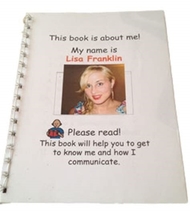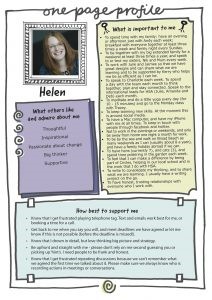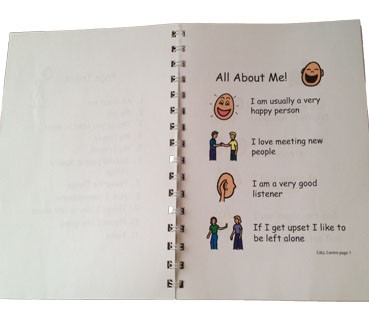Tip of the Month - April 2020 - Communication Passports
What is a communication passport?
A communication passport is an individualised booklet about a person. It gives the person a voice to share key information about themselves, to help others get to know him or her. The passport can be used by new people (e.g. new care givers, health professionals or friends) to get to know this person better. The passport is a quick way to understand things that the person cannot communicate about themselves, e.g. how best to support understanding, dietary requirements and medication information as well as likes and dislikes and topics they like to chat about. Communication passports can be used by children and adults as they are always highly personalised. They are very useful when transitioning between services or when new people come into their life.

How to create a communication passport?
Try to get the person to decide what should go in the passport as much as possible, so that it is a reflection of their own views and preferences.
Write the passport from the person’s point of view - make the dialogue chatty rather than professional.
Draw together information from past and present and from different contexts so that it paints a holistic picture of the person.
As time goes by things can change, so please update it when required.
Remember to present the person positively – not just as a set of ‘problems’ or medical needs.
Feel free to add pictures, photographs and additional sections to help make it a very valuable personal resource. Equally, feel free to delete any sections which do not apply.

When to use a communication passport?
Communication books are useful when there are new people around, e.g. transitioning to a new school, visiting the hospital, moving into a retirement home, etc. Make sure you have it in a really visible place for new people to look through, e.g. a new nurse starts his shift and the communication book is sitting on a table at the end of the bed, so he can quickly read through it while introducing himself and have a few ideas on how best to communicate and some topics that are good to talk about, as well as some things that the person does not like.
Who can make a communication passport?
Anyone can make one! The most important thing is to involve the person as much as possible when choosing the content and how it looks – adding borders, colours, photos, etc. You can hand write this or type/edit it on a computer. Or you could create your own passport using a scrapbook or a clear file. There is a full template and a short one page template at the end of this document which you can edit. If you don’t like the symbols, feel free to delete them and add your own photos. You could also add a contents page at the start of the book with the title of each page in order to find info quickly.
Ministry of Health also have a free template Health Passport available for download here, which you can carry with you when you go to hospital or when you use other health and disability services, such as your GP or a new carer: https://www.health.govt.nz/your-health/services-and-support/health-care-services/health-passport

To download this Tip of the Month and some Communication Passport templates as a PDF, please click here
To download this Tip of the Month and some Communication Passport templates as a Word Document, please click here
References:
https://www.specialneedsjungle.com/one-page-profile-can-improve-special-needs-childs-life/ and
https://www.communicationpassports.org.uk/creating-passports/
What is a communication passport?
A communication passport is an individualised booklet about a person. It gives the person a voice to share key information about themselves, to help others get to know him or her. The passport can be used by new people (e.g. new care givers, health professionals or friends) to get to know this person better. The passport is a quick way to understand things that the person cannot communicate about themselves, e.g. how best to support understanding, dietary requirements and medication information as well as likes and dislikes and topics they like to chat about. Communication passports can be used by children and adults as they are always highly personalised. They are very useful when transitioning between services or when new people come into their life.

How to create a communication passport?
Try to get the person to decide what should go in the passport as much as possible, so that it is a reflection of their own views and preferences.
Write the passport from the person’s point of view - make the dialogue chatty rather than professional.
Draw together information from past and present and from different contexts so that it paints a holistic picture of the person.
As time goes by things can change, so please update it when required.
Remember to present the person positively – not just as a set of ‘problems’ or medical needs.
Feel free to add pictures, photographs and additional sections to help make it a very valuable personal resource. Equally, feel free to delete any sections which do not apply.

When to use a communication passport?
Communication books are useful when there are new people around, e.g. transitioning to a new school, visiting the hospital, moving into a retirement home, etc. Make sure you have it in a really visible place for new people to look through, e.g. a new nurse starts his shift and the communication book is sitting on a table at the end of the bed, so he can quickly read through it while introducing himself and have a few ideas on how best to communicate and some topics that are good to talk about, as well as some things that the person does not like.
Who can make a communication passport?
Anyone can make one! The most important thing is to involve the person as much as possible when choosing the content and how it looks – adding borders, colours, photos, etc. You can hand write this or type/edit it on a computer. Or you could create your own passport using a scrapbook or a clear file. There is a full template and a short one page template at the end of this document which you can edit. If you don’t like the symbols, feel free to delete them and add your own photos. You could also add a contents page at the start of the book with the title of each page in order to find info quickly.
Ministry of Health also have a free template Health Passport available for download here, which you can carry with you when you go to hospital or when you use other health and disability services, such as your GP or a new carer: https://www.health.govt.nz/your-health/services-and-support/health-care-services/health-passport

To download this Tip of the Month and some Communication Passport templates as a PDF, please click here
To download this Tip of the Month and some Communication Passport templates as a Word Document, please click here
References:
https://www.specialneedsjungle.com/one-page-profile-can-improve-special-needs-childs-life/ and
https://www.communicationpassports.org.uk/creating-passports/
